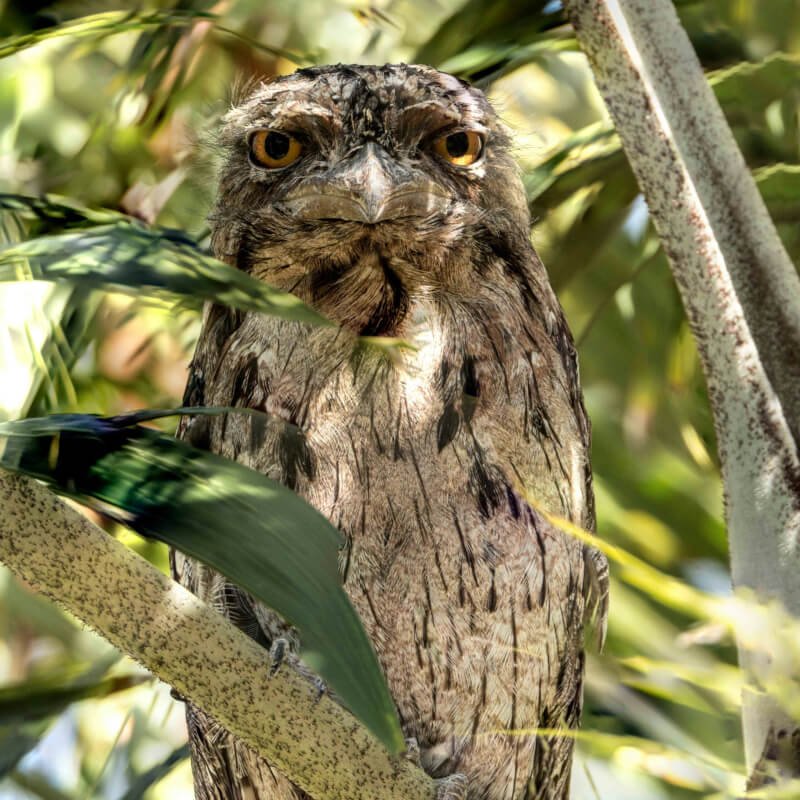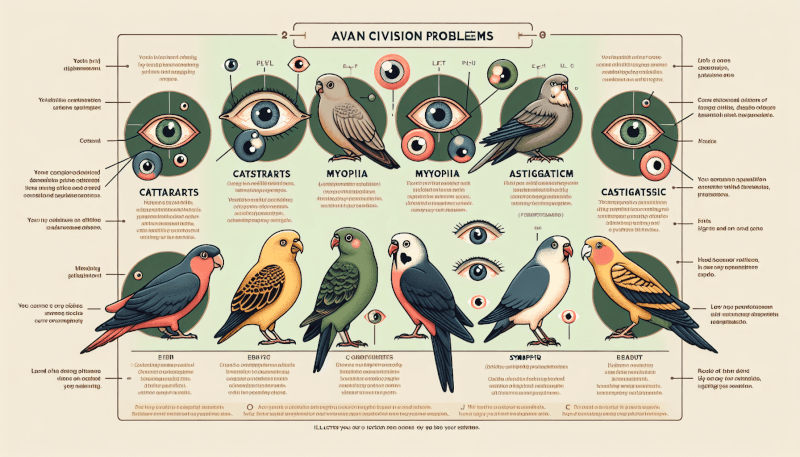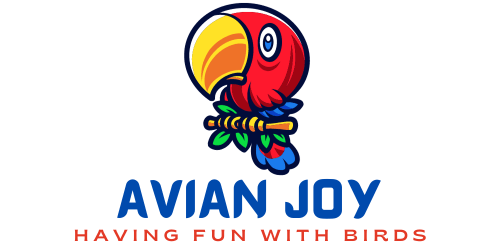Have you ever wondered if your feathered friend is having trouble seeing? In this article, we will explore the fascinating world of avian vision and provide you with valuable insights on how to recognize and address potential visual impairments in your avian companion. From understanding common signs of vision problems to learning effective strategies for prevention and treatment, we’ve got you covered. With our help, you’ll be able to ensure your bird’s ocular health and enhance their overall quality of life. So let’s dive right in and discover the key to recognizing and addressing avian vision problems!

Understanding Avian Vision
The unique characteristics of avian vision
Avian vision is a fascinating and complex subject that sets birds apart from other animals. Birds have a remarkably high visual acuity, allowing them to see details with exceptional clarity. Their eyes are also adapted for a wide range of light conditions, including the ability to see into the ultraviolet spectrum. This unique ability allows birds to perceive colors and patterns that are invisible to humans. Birds also have a larger field of vision than humans, thanks to their ability to rotate their eyes independently, allowing them to see a wide range of angles simultaneously.
Common vision problems in birds
Just like humans and other animals, birds can also experience vision problems. These problems can range from minor irritations to serious conditions that can greatly impact a bird’s quality of life. Some of the most common vision problems in birds include cataracts, glaucoma, nystagmus, refractive errors, macular degeneration, retinal detachment, and infections. It is important for bird owners to be aware of these potential issues and know how to recognize the signs of a vision problem in their feathered friends.
Recognizing Avian Vision Problems
Observing behavioral changes
One of the first signs that your bird may be experiencing vision problems is changes in its behavior. If your usually active and playful bird becomes lethargic or withdrawn, it could be a sign that it is struggling to see properly. Birds with vision problems may also become more aggressive or fearful, as they may feel vulnerable due to their reduced visual acuity. Additionally, if your bird starts to exhibit signs of depression or seems disinterested in its surroundings, it could be a result of vision impairment.
Abnormal flight patterns
Birds with vision problems may also exhibit abnormal flight patterns. They may have difficulty navigating through their environment or may crash into objects as they attempt to fly. If you notice your bird flying into walls or furniture, it is a clear indication that it is struggling to see its surroundings properly. It is important to ensure that your bird’s flight area is free from obstacles to prevent any accidents or injuries.
Squinting or blinking excessively
If you see your bird squinting or blinking excessively, it could be a sign of eye discomfort or vision problems. Squinting is a natural reflex that helps protect the eyes from bright light or foreign objects. However, if your bird is consistently squinting even in normal lighting conditions, it may indicate a more serious vision issue, such as an eye infection or glaucoma.
Difficulty locating food or perches
Birds with vision problems may have difficulty locating their food or perches. They may struggle to find their food dishes or fail to land on perches properly. This can lead to malnutrition or injuries caused by falls. If you notice that your bird is having trouble finding its food or consistently misses its perches, it is crucial to address the issue promptly to prevent any adverse effects on its health.
Bumping into objects
A clear sign of vision problems in birds is when they consistently bump into objects in their environment. Birds with impaired vision may misjudge distances or fail to detect objects in their path, leading to frequent collisions. If you find your bird frequently crashing into toys, walls, or other objects, it is essential to take action to protect its safety and well-being.
Reduced grooming behavior
A bird’s grooming behavior includes activities like preening and maintaining its feathers. However, birds with vision problems may have difficulty performing these grooming tasks properly. They may neglect their feathers or exhibit a disheveled appearance. It is crucial to regularly check your bird’s feathers and be aware of any changes in its grooming behavior, as it can be an indication of underlying vision issues.

Common Avian Vision Disorders
Cataracts
Cataracts in birds are characterized by the clouding of the lens of the eye, leading to blurred vision or even blindness. This condition can be caused by genetic factors, aging, or trauma to the eye. Cataracts can affect birds of all ages and can significantly impact their ability to see clearly. Surgical intervention is often necessary to remove the cataracts and restore vision.
Glaucoma
Glaucoma is a condition that occurs when there is increased intraocular pressure within the eye, which can damage the optic nerve and lead to vision loss. Birds with glaucoma may experience redness and pain in the affected eye, and in severe cases, they may become blind. Treatment options for glaucoma in birds include medication, surgery, and managing underlying conditions that contribute to the increased pressure.
Nystagmus
Nystagmus is characterized by involuntary eye movements that can cause visual disturbances for birds. These rapid and uncontrollable eye movements can impact a bird’s ability to focus and track objects, affecting their overall vision. Nystagmus can be caused by neurological disorders, exposure to toxins, or trauma. Treatment options for nystagmus depend on the underlying cause and may include medication, surgery, or supportive care.
Refractive errors
Similar to humans, birds can also experience refractive errors, such as nearsightedness or farsightedness. These errors occur when the curvature of the cornea or lens prevents light from properly focusing on the retina. Refractive errors can cause blurred vision or difficulty focusing on objects at different distances. Corrective measures, such as glasses or contact lenses, can help improve a bird’s vision in cases of refractive errors.
Macular degeneration
Macular degeneration is a condition that affects the macula, the central portion of the retina responsible for sharp, detailed vision. This degenerative condition can lead to central vision loss and a reduction in visual acuity. Macular degeneration in birds can be caused by aging or nutritional deficiencies. Although there is no cure for macular degeneration, supportive care and dietary changes may help slow down its progression and support overall eye health.
Retinal detachment
Retinal detachment occurs when the retina detaches from the underlying tissue, disrupting the normal functioning of the visual system. This condition can cause partial or complete vision loss in affected birds. Retinal detachment can be caused by trauma, genetic factors, or underlying health conditions. Treatment options for retinal detachment include surgery and supportive care to protect the affected eye and prevent complications.
Infections
Infections can also cause vision problems in birds. Bacterial, viral, or fungal infections can affect different structures of the eye, leading to inflammation, discharge, and vision impairments. Prompt diagnosis and appropriate treatment with medications or topical ointments are essential to prevent further complications and preserve the bird’s vision.
Diagnosing Avian Vision Problems
Consulting an avian veterinarian
If you suspect that your bird is experiencing vision problems, it is vital to consult an avian veterinarian who has experience in diagnosing and treating avian eye conditions. They will thoroughly examine your bird and conduct necessary tests to determine the underlying cause of the vision problems.
Physical examination and medical history
During the veterinary visit, the avian veterinarian will perform a physical examination of your bird, paying particular attention to its eyes. They will also inquire about the bird’s medical history, including any previous instances of eye problems or injuries.
Vision tests and assessments
Avian veterinarians may use various vision tests and assessments to evaluate your bird’s visual acuity and identify any specific deficits. These tests can include assessing the bird’s response to light, visual tracking, and evaluating their ability to detect and recognize objects.
Advanced diagnostics like ophthalmoscopy
In some cases, avian veterinarians may need to perform more advanced diagnostics, such as ophthalmoscopy, to closely examine the structures of the bird’s eye. Ophthalmoscopy allows the veterinarian to visualize the retina, optic nerve, and other internal components of the eye, providing valuable information for diagnosis and treatment planning.

Preventing Avian Vision Problems
Providing a safe and stimulating environment
One of the most crucial aspects of preventing avian vision problems is providing a safe and stimulating environment for your bird. Ensure that your bird’s cage or aviary is free from sharp objects or potential hazards that could injure their eyes. Offering a variety of toys and perches can stimulate their visual senses and promote mental engagement.
Regular veterinary check-ups
Regular veterinary check-ups are essential for maintaining your bird’s overall health, including their vision. Routine examinations can help detect any potential vision problems at an early stage, allowing for prompt intervention and treatment.
Proper diet and nutrition
A balanced and nutritious diet is essential for maintaining good eye health in birds. Providing a diet that is rich in essential vitamins and minerals, such as vitamin A, can support optimal eye function and reduce the risk of vision problems. Consult with your avian veterinarian for specific dietary recommendations for your bird’s species.
Maintaining optimal lighting conditions
Lighting conditions play a significant role in avian vision. Birds require appropriate lighting to see properly and regulate their sleep-wake cycles. Ensure that your bird has access to natural daylight or provide full-spectrum artificial lighting that mimics natural sunlight. Avoid exposing your bird to excessive or prolonged periods of darkness, as it can negatively impact their vision and overall well-being.
Avoiding exposure to toxins
Toxins can have detrimental effects on a bird’s vision and overall health. Ensure that your bird’s environment is free from toxic substances, such as tobacco smoke, aerosol sprays, or household cleaners. Be cautious of plants that may be toxic to birds as well. Regularly clean and sanitize your bird’s living space to prevent the buildup of harmful bacteria or allergens.
Treating Avian Vision Problems
Medical interventions like medication or surgery
The treatment approach for avian vision problems depends on the specific condition and its severity. In some cases, medical interventions such as medications or surgical procedures may be necessary to address the underlying cause of the vision problem and restore or improve vision.
Optical aids and devices
Optical aids and devices can be beneficial for birds with vision problems, especially those with partial vision loss. These can include specialized eyewear, contact lenses, or magnifying devices that help enhance a bird’s remaining vision and improve their quality of life.
Vision therapy and rehabilitation
Vision therapy and rehabilitation techniques can help birds with vision problems maximize their visual potential and adapt to their new visual capabilities. These techniques may involve exercises and activities that stimulate the bird’s vision and encourage visual recognition and tracking.
Adapting the bird’s environment
Adapting the bird’s environment to accommodate their vision problems is essential for their safety and well-being. This can include removing or rearranging obstacles to reduce the risk of collisions, providing contrasting colors or textures to aid in visual detection, and ensuring that perches and feeding areas are easily accessible.

Living with a Visually Impaired Bird
Creating a bird-friendly environment
Living with a visually impaired bird requires creating a bird-friendly environment that takes their vision limitations into account. Ensure that their space is clutter-free and well-organized, providing clear pathways for them to navigate. Use auditory cues, such as bells or chimes, to help orientate them in their environment.
Developing a consistent routine
Establishing a consistent daily routine can help visually impaired birds feel more secure and confident in their surroundings. Stick to regular feeding, playtime, and training sessions to create a predictable and familiar environment for them.
Helping the bird navigate its surroundings
Assist your visually impaired bird in navigating its surroundings by providing landmarks or tactile cues. For example, you can place textured objects or mats near perches, or use scented markers to mark important areas of their living space.
Adaptive training techniques
Using adaptive training techniques can help visually impaired birds learn new behaviors and adapt to their vision limitations. Positive reinforcement-based training methods can help them understand cues through sound or touch, allowing them to engage in enrichment activities and interact with their environment more confidently.
Special Considerations for Different Bird Species
Cockatiels
Cockatiels are known for their keen sense of vision and adaptability. However, they can still develop vision problems, especially as they age. Regular veterinary check-ups and a balanced diet are essential for maintaining their visual health.
Parrots
Parrots rely heavily on their vision for communication and foraging. Any changes in their visual abilities can have a significant impact on their overall well-being. Providing a stimulating environment and regular veterinary care can help prevent and address vision problems in parrots.
Canaries
Canaries are highly dependent on their vision for navigation and singing. Ensuring they have access to proper lighting conditions and a nutritious diet can help maintain their visual health and support their beautiful songs.
Finches
Finches have very sharp eyesight and are known for their ability to spot small insects or prey from a distance. Regular veterinary care and providing a safe environment with appropriate lighting can help prevent vision problems in finches.
Birds of prey
Birds of prey, such as eagles or hawks, have excellent vision that is critical for hunting. They must receive proper veterinary care and maintain an optimal environment to support their acute visual capabilities.
Waterfowl
Waterfowl, such as ducks or geese, rely on their vision for navigation and foraging. Regular veterinary check-ups and ensuring access to natural water sources are important for their overall visual health.
Penguins
Penguins have adapted to see clearly underwater, enabling them to locate their food and navigate underwater environments. Maintaining optimal water quality and providing a stimulating habitat is crucial for their visual well-being.
Avian Vision Research and Future Developments
Advancements in avian ophthalmology
Avian ophthalmology is a rapidly advancing field, with ongoing research and advancements aimed at improving our understanding of avian vision and developing more effective treatments for eye conditions in birds. Researchers and veterinarians continue to investigate new techniques, medications, and surgical approaches to address vision problems in avian patients.
Emerging treatment options
Advancements in technology and medical knowledge are continuously expanding the range of available treatment options for avian vision problems. From new medications to innovative surgical procedures, these emerging treatments offer hope for improved outcomes and enhanced quality of life for visually impaired birds.
Ongoing research on avian vision
Researchers are dedicated to studying avian vision to unlock its many secrets and understand the intricate workings of avian eyes. Ongoing research focuses on topics such as avian color vision, visual development in birds, and the impact of various environmental factors on avian eye health. These studies contribute to the growing body of knowledge and pave the way for advancements in avian vision care.
Conclusion
Avian vision is a remarkable aspect of birds’ physiology, allowing them to perceive the world in unique and incredible ways. However, birds can also experience vision problems that can impact their daily lives. By understanding the signs of avian vision problems, seeking prompt veterinary care, and implementing appropriate preventative measures, bird owners can ensure their feathered friends enjoy a healthy and fulfilling life. Ongoing research and advancements in avian ophthalmology offer exciting prospects for the future, with improved treatments and a deeper understanding of avian vision on the horizon. With proper care and attention, we can help our visually impaired avian companions thrive and continue to amaze us with their resilience and adaptability.


